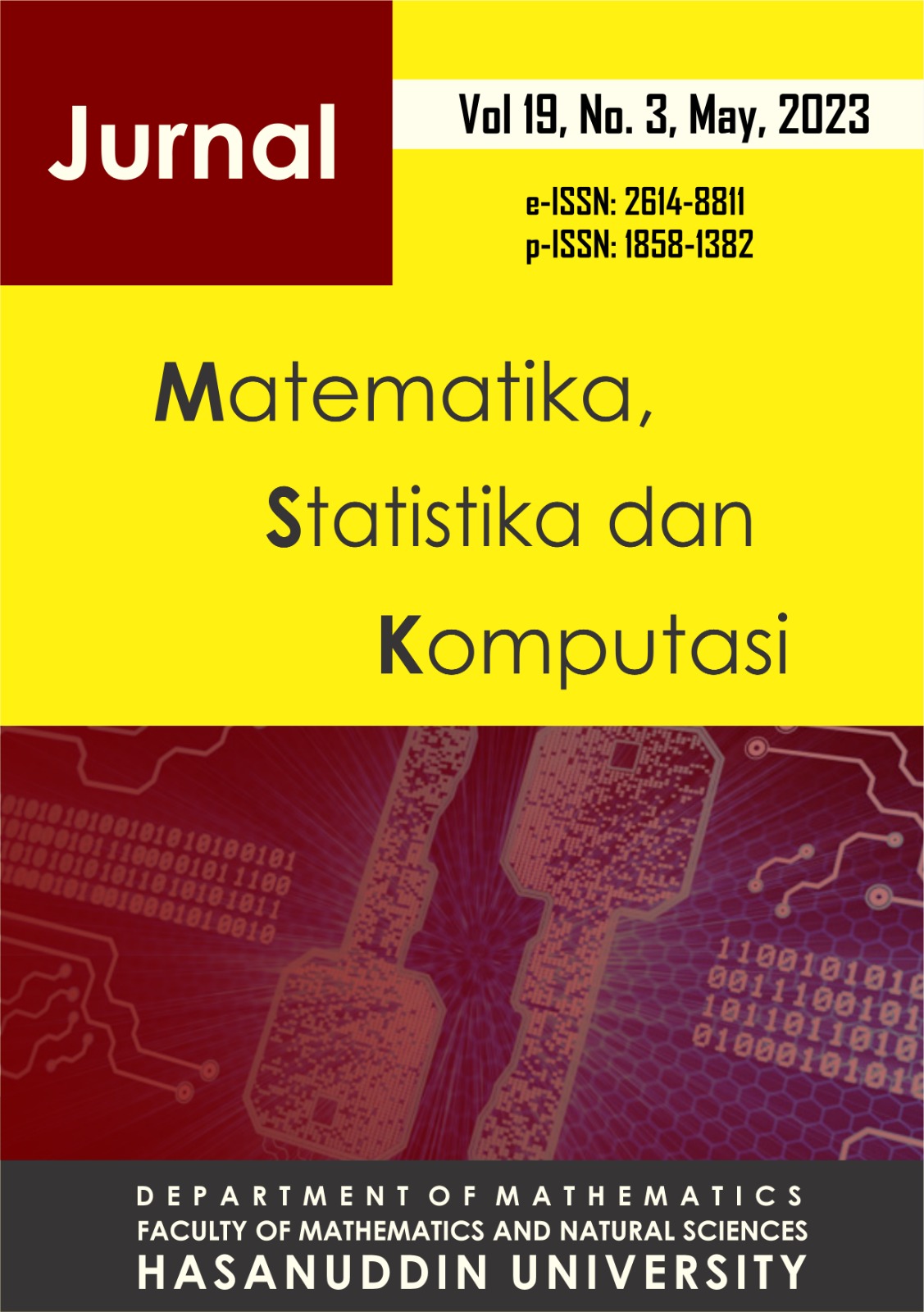Forecasting The Search Trends of The Keyword “Sarung Wadimor” In Indonesia on Google Trends Data Using Time Series Regression with Calender Variation and Arima Box-Jenkins
DOI:
https://doi.org/10.20956/j.v19i3.24551Keywords:
ARIMA, Google Trends, Time Series Regression, WadimorAbstract
The impact of this 4.0 era is that data is growing and can be collected very easily and then reprocessed to obtain information. One of the search engines for various data and information that is often used is Google, causing a high search intensity and will further impact on increasing the amount of data generated by search engines. Google Trends is one of the official websites from Google that reflects or takes pictures of events in society based on search keywords. The search keyword that will be studied in this article is “Sarung Wadimor”. Therefore, the purpose of this research is to forecast the search trend for the keyword "Sarung Wadimor" which is interesting because the resulting time series data pattern shows a recurring pattern due to the effect of calendar variations which are thought to be related to the month of Ramadan. Forecasting modeling uses Autoregressive Integrated Moving Average (ARIMA) and Time Series Regression (TSR). The goodness of the model used in this article is the Mean Square Error (MSE), Root Mean Square Error (RMSE), and Symmetric Mean Absolute Percentage Error (SMAPE). Based on the results of the analysis, using three goodness-of-fit measures shows that the TSR model with the Calendar Variation of Ramadan + Month Periods has smaller MSE, RMSE, and SMAPE values than the other models with goodness-of-fit values of 88.602, 9.413, and 26.950, respectively. Forecasting results for the next 6 periods show that the search trend for the keyword "Sarung Wadimor" tends to decrease, this is because the month of Ramadan is still quite far in 2023.
References
Alabdulrazzaq, H., Alenezi, M. N., Rawajfih, Y., Alghannam, B. A., Al-Hassan, A. A., & Al-Anzi, F. S., 2021. On the accuracy of ARIMA based prediction of COVID-19 spread. Results in Physics, Vol. 27. https://doi.org/10.1016/j.rinp.2021.104509
Arumsari, M., & Dani, A. T. R., 2021. Peramalan Data Runtun Waktu menggunakan Model Hybrid Time Series Regression – Autoregressive Integrated Moving Average. Jurnal Siger Matematika, Vol. 2, No. 1, 1–12.
Babii, A., Ghysels, E., & Striaukas, J., 2022 Machine Learning Time Series Regressions With an Application to Nowcasting. Journal of Business and Economic Statistics, Vol. 40. No. 3, 1094–1106.
Dani, A. T. R., Wahyuningsih, S., & Rizki, N. A., 2019. Penerapan Hierarchical Clustering Metode Agglomerative pada Data Runtun Waktu. Jambura Journal of Mathematics, Vol. 1, No. 2, 64–78.
Duanaputri, R., Sulistyowati, S., & Insani, P. A., 2022. Analisis peramalan kebutuhan energi listrik sektor industri di Jawa Timur dengan metode regresi linear. Jurnal Eltek, Vol. 20, No. 2.
Elsaraiti, M., & Merabet, A., 2021. A comparative analysis of the arima and lstm predictive models and their effectiveness for predicting wind speed. Energies, Vol. 14, No. 20.
Emiro, A., Hasan, I. K., & Achmad, N., 2023. Perbandingan Model ARIMA-RBF dan ARIMA-GARCH dalam Peramalan Time Series Inflasi Provinsi Gorontalo. Research in the Mathematical and Natural Sciences, Vol. 2, No. 1, 9–17.
Perone, G., 2022. Comparison of ARIMA, ETS, NNAR, TBATS and hybrid models to forecast the second wave of COVID-19 hospitalizations in Italy. European Journal of Health Economics, Vol. 23, No. 6, 917–940.
Ramadani, K., Wahyuningsih, S., & Hayati, M. N., 2022. Forecasting Stock Price PT. Telkom Using Hybrid Time Series Regression Linear– Autoregressive Integrated Moving Average Model. Jurnal Matematika, Statistika Dan Komputasi, Vol. 18, No. 2, 293–307.
Ramadhani, A., Wahyuningsih, S., & Siringoringo, M., 2022. Forecasting the Number of Foreign Tourist Visits to Indonesia Used Intervention Analysis with Step Function. Jurnal Matematika, Statistika Dan Komputasi, Vol. 19, No. 1, 146–162.
Rizki, S. W., Statistika, S., & Yundari., 2022. Combined Model Time Series Regression – ARIMA on Stocks Prices. TENSOR: Pure and Applied Mathematics Journal, Vol. 3, No. 2, 65–72.
Saputra, A. R., Wahyuningsih, S., & Siringoringo, M., 2021. Peramalan Jumlah Titik Panas Provinsi Kalimantan Timur Menggunakan Analisis Intervensi Fungsi Pulse Forecasting Number of Hotspots in East Borneo using Pulse Function of Intervention Analysis. Jurnal EKSPONENSIAL, Vol. 12, No. 1.
Satrio, C. B., Darmawan, W., Nadia, B. U., & Hanafiah, N., 2021. Time series analysis and forecasting of coronavirus disease in Indonesia using ARIMA model and PROPHET. Procedia Computer Science, Vol. 179, 524–532.
Widyarsi, L., & Usman, H., 2021. Penggunaan Data Google Trends untuk Peramalan Tingkat Pengangguran Terbuka di Tingkat Nasional dan Regional di Provinsi Jawa Barat. Prosiding Seminar Nasional Official Statistics, Vol. 2021, No. 1, 980–990.
Wirdyacahya, B. S., & Prastuti, M., 2022. Peramalan Permintaan Semen di PT. XYZ Menggunakan Time Series Regression dan ARIMA. Jurnal Sains Dan Seni ITS, Vol. 11, No. 1.
Zhao, D., Zhang, R., Zhang, H., & He, S., 2022. Prediction of global omicron pandemic using ARIMA, MLR, and Prophet models. Scientific Reports, Vol. 12, No. 1, 1–13.
Downloads
Published
How to Cite
Issue
Section
License
Copyright (c) 2023 Author and publisher

This work is licensed under a Creative Commons Attribution 4.0 International License.

This work is licensed under a Creative Commons Attribution 4.0 International License.
Jurnal Matematika, Statistika dan Komputasi is an Open Access journal, all articles are distributed under the terms of the Creative Commons Attribution License, allowing third parties to copy and redistribute the material in any medium or format, transform, and build upon the material, provided the original work is properly cited and states its license. This license allows authors and readers to use all articles, data sets, graphics and appendices in data mining applications, search engines, web sites, blogs and other platforms by providing appropriate reference.







